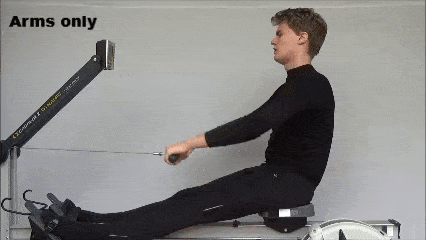|
|
Recovery – Dynamic lengthening |
| Practice: | Three strokes fixed seat and fixed trunk (arms only), then three strokes fixed seat or ¼ seat (arms and trunk only), finally three strokes full stroke. Then back again via three strokes arms and trunk only to three strokes arms only. If three strokes are experienced as too uneasy, use five or ten strokes. |
| Type: |  Motor exercise developed by Motor exercise developed by  Jeroen Brinkman. Has a better transfer than Jeroen Brinkman. Has a better transfer than  Lengthening out. Lengthening out. |
| Purpose: | Good teaching of the movement sequence during the recovery, by dividing the recovery into three parts. These are the: arms (fixed seat and trunk), arms and trunk (¼ seat) and arms, trunk and legs (complete stroke). |
| Focus: | Arms only: pay attention to the synchronous lowering of the handles, initial away and a clean finish while keeping balance; ¼ seat: also pay attention to the rotation of the trunk at the same time as the other rowers; full stroke: pay attention to the similarity of the whole recovery. |
| Variation: | For rowers that are not able to move only 5 centimeters forward when rowing ¼ seat, use fixed seat instead of ¼ seat. Let the rower(s) decide for themselves when it goes well enough to lengthen. For synchronising the trunk swing, the variant with alternating one stroke ¼ seat and one full stroke is very effective. Focus on the evenness of rotating the trunk. Also see:  Practice draw sequence. Practice draw sequence. |

Dynamic lengthening
 |
Recovery – Blade trail variations |
 |
Recovery – Practice body over |
This article was translated automatically and is provided to you for free. You are most welcome to improve it!











